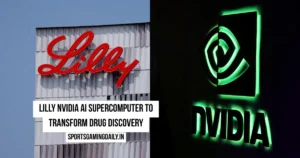Since the beginning of this decade, and especially heading into 2025, the concept of NVIDIA AI dominance has become a reality rather than just a vision. From the data-centres powering large language models to the cloud infrastructure that underpins many top tech firms, NVIDIA has firmly established itself as the front-runner. Even in a year when competition is heating up, the term “NVIDIA AI dominance” perfectly captures the company’s position. And yes as noted by sports industry watchers such as sportsgamingdaily, the parallels between high-performance computing and performance in sports are striking.
Unpacking the scale of NVIDIA AI dominance
First, let’s look at raw numbers. According to a recent report, NVIDIA controls around 92 % of the data-centre GPU market in 2024 and into 2025. That kind of share is extraordinary in any technology cycle. The firm’s GPUs are not just popular: they have become standard for AI model training and inference at the largest scale.
Furthermore, analysts estimate that NVIDIA holds roughly 80 % to 90 % of the AI accelerator market in key segments. That means when an organisation says “we’re building out our AI infrastructure in 2025”, more often than not they are working with NVIDIA hardware and the ecosystem that supports it.
So when we speak of “NVIDIA AI dominance”, we are referring to both the scale of deployment and the entrenched position of its technology across industries.
Why NVIDIA continues to lead key reasons
There are multiple factors behind the sustained momentum of NVIDIA AI dominance.
1. The broad GPU ecosystem and the CUDA-software moat.
NVIDIA built not just hardware but a whole stack. Its programming model and software ecosystem, the CUDA ecosystem, enable developers and researchers to train large models efficiently. Reports indicate that the CUDA ecosystem remains a differentiator for why NVIDIA remains dominant.In short, switching away becomes costly for large-scale organisations.
2. Dominance in data-centre AI infrastructure.
Enterprises and cloud providers are building out AI infrastructure at massive scale. NVIDIA’s GPUs are the backbone of many such deployments. Because of that, its dominance in “NVIDIA data center AI infrastructure” is almost baked into the architecture choices of major players.
3. Momentum and network effects.
Because many large players already deploy NVIDIA hardware, there is an inertia to stick with that ecosystem. There’s tooling, training, libraries, and experience. That gives NVIDIA a growing lead that is difficult for new entrants to overcome quickly.
4. Strategy for maintaining leadership.
NVIDIA has maintained focus on ramping up architecture improvements, optimising power and performance, and targeting large AI workloads. That speaks to the keyword “Why NVIDIA dominates the AI chip market in 2025” and “NVIDIA’s strategy for maintaining AI market leadership.” Its strategic roadmap emphasises not just incremental improvements but major leaps in GPU architectures. For instance, the firm’s Blackwell architecture is a key example.
5. Scale in both hardware and software across verticals.
Because AI is no longer a niche, but a core element in many industries (automotive, healthcare, retail, finance), the firm’s ability to serve across usage-cases gives it another edge. In turn, the “NVIDIA GPU ecosystem and AI model training advantage” phrase helps highlight that they are not just selling chips but enabling full model training pipelines.
6. Competitive moat in end-to-end infrastructure.
It is not just about the chip. It’s about interconnects, memory, networking, software, ecosystem, cloud partnerships. The phrase “How NVIDIA’s AI infrastructure drives data centre growth in 2025” is apt: NVIDIA’s gear is central to the growth engines of large cloud and enterprise data centres.
NVIDIA vs competitors why the gap remains wide
When comparing “NVIDIA vs competitors AI chips”, some important dynamics stand out.
On one hand, legacy competitors like AMD and Intel are making visible pushes. For example, AMD’s MI300 series and Intel’s Gaudi chips aim to capture parts of the market.
However, despite this activity, they remain far behind in both share and ecosystem maturity. The scale of NVIDIA’s installation base, software familiarity, and performance leadership affords it a wide lead.
Additionally, for many hyperscale customers, switching away from NVIDIA involves disruption, cost escalation, and ecosystem risk which many avoid. That is part of why “Key reasons NVIDIA continues to lead in AI despite rising competition” remain valid.
Thus, even as competitor announcements rise, the reality in 2025 is that NVIDIA’s lead remains largely unthreatened at scale.
Looking deeper at the “NVIDIA AI market 2025” landscape
In 2025, the AI market is growing faster than ever. Large language models, generative AI, autonomous systems all demand massive compute. The “NVIDIA AI market 2025” framing helps us appreciate the broader demand. For instance:
- The data-centre GPU market grew from roughly $17 billion in 2022 to around $125 billion in 2024.
- The strong demand for model training, inference, and large scale AI infrastructure means NVIDIA’s addressable market is expanding rapidly.
In that environment, NVIDIA AI dominance doesn’t just reflect past success it reflects strong alignment with current demand. Because the firm is already deeply embedded, it is positioned to capture the growth.
For readers of sportsgamingdaily, one might draw the analogy to a sports team that not only wins championships but controls the trade market, the scouting network, and the youth pipeline. By the time challengers arrive, it is already entrenched. That captures the mindset behind why NVIDIA’s hold is strong.
What could challenge the lead and how NVIDIA is responding
Although NVIDIA’s position is robust, no lead is immune to change. Potential risks include:
- Competitors ramping up faster than expected and building credible hardware + software stacks.
- Geopolitical restrictions and supply-chain risks affecting availability.
- New architectures (e.g., custom AI accelerators built by big cloud companies) eating into the merchant market.
Despite these risks, NVIDIA seems aware and responds accordingly. Its strategy for maintaining AI market leadership emphasises both hardware refresh cycles and ecosystem depth. Its investments in software, training libraries, networking, and developer tools all serve to widen the moat.
As a result, even in 2025 the concept of NVIDIA AI dominance remains not just descriptive but predictive: the firm appears set to hold its lead going forward though it cannot be complacent.
Implications for businesses and developers
For businesses deploying AI now or over the next few years, the dominance of NVIDIA means clear practical considerations:
- Choosing NVIDIA hardware often means smoother integration, more mature tooling, and lower risk of vendor lock-in surprises.
- For developers, being skilled in the CUDA ecosystem and NVIDIA tools gives a marketplace advantage.
- For enterprises building out large-scale AI infrastructure, aligning with NVIDIA may reduce the time-to-value as opposed to exploring less-mature alternatives.
- Conversely, organisations weighing cost or vendor diversity should still monitor alternative chips but should also recognise that departing from the NVIDIA ecosystem may introduce trade-offs.
Conclusion
In summary, the phrase NVIDIA AI dominance captures a truth about 2025: NVIDIA leads not because of luck but because it built hardware, software, and ecosystem in parallel exactly when the world needed them. The “NVIDIA AI market 2025” is growing fast, and NVIDIA’s share in that growth remains extraordinary. Through the “NVIDIA GPU market share”, its “NVIDIA data centre AI infrastructure”, and the investment in the “NVIDIA CUDA ecosystem”, the firm has assembled a lead that most rivals will find hard to close.
For sportsgamingdaily, the story is reminiscent of a team that controls the draft, the talent, the training system and as a result wins consistently. In the AI chip arena, NVIDIA’s advantage is similar. If you ask “Why NVIDIA dominates the AI chip market in 2025”, the answer lies in that multi-layer lead: hardware + software + ecosystem + execution. The company’s strategy for maintaining AI market leadership appears solid and the scale it commands means that “how NVIDIA’s AI infrastructure drives data centre growth in 2025” is already visible in many cloud and enterprise builds.
Therefore, while competition will continue to intensify, for now NVIDIA’s dominance remains unrivalled.










